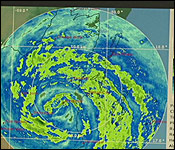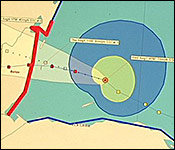
 So, in view of all the wreckage that Hurricane Earl generated, really just how strong was Hurricane Earl when it made landfall in Belize? The local experts from the Belize Meteorological Service are still reviewing the data recorded at their different measuring stations. According to the National Hurricane Center, when Earl finally passed over the country, it's maximum sustained winds at midnight on Wednesday were measured at 80 miles per hour.
So, in view of all the wreckage that Hurricane Earl generated, really just how strong was Hurricane Earl when it made landfall in Belize? The local experts from the Belize Meteorological Service are still reviewing the data recorded at their different measuring stations. According to the National Hurricane Center, when Earl finally passed over the country, it's maximum sustained winds at midnight on Wednesday were measured at 80 miles per hour.
Now, if you ask anyone in the affected areas on the Cayes, Belize City, Ladyville, and those communities along the Phillip Goldson Highway, they'll tell you that certainly, the winds which hit them were certainly more than 80 miles per hour. So, today, we went to talk with Dennis Gonguez, the Chief Met Officer, and he told us that people may well have experienced winds over 80 miles, but those were gusts, which is different from the maximum sustained winds.
As viewers know, the strength of a hurricane is measured by its maximum sustained winds, which is average of all wind speeds over a minute. A gust, is short burst of wind over 3 to 5 seconds at a time, which can definitely go higher than its maximum sustained winds.
Today, Gonguez told us that the strongest gust that their instruments picked up was 105 miles per hour at Halfmoon Caye. But, in Belize City and Ladyville, the maximum sustained winds, which is the true measure of hurricane's strength was only 61 and 67 miles per hour. Here's how he explained the difference and why Belizeans definitely perceived a stronger storm than forecast:
Dennis Gonguez, Chief Met Officer
"Typically when we say the maximum sustained winds, we are talking of the one minute average in the wind speeds."
Daniel Ortiz
"What in your mind is the maximum short bursts of wind we experienced through the storm?"
 Dennis Gonguez, Chief Met Officer
Dennis Gonguez, Chief Met Officer
"I would have to go with the half-moon caye data about 105 miles per hour gusts because we have that as the evidence that we did have a gust of 105 so I'd have to go with the half-moon caye data that we had which is 105 mph gust. Our maximum sustained winds that were measured from hurricane earl were 67 mph which we measured in Belize City at the port of Belize. Here at the international airport we had 61 mph. however at half-moon caye we had a gust of 104 mph."
Daniel Ortiz
"And those were 3-5 seconds right?"
Dennis Gonguez, Chief Met Officer
"Right, these are short pulses in the wind. We had a gust of 104 mph here at half-moon caye so it is possible that we felt winds near to 100 mph giving us the feeling that the system was stronger than a category one. When in reality it was in the vicinity of a category one with 67 mph winds measured."
Daniel Ortiz
"Explain to us where exactly earl passed Belize. Where did the eye of the storm actually make landfall?"
Dennis Gonguez, Chief Met Officer
"Earl made landfall at about 11:53pm on Wednesday night at about 13 miles south west of Belize city. That's just near northern lagoon and at that time, like I said, the surge upon landfall, all the counterclockwise winds brought up all that storm surge into Ladyville and Vista Del Mar area. I visited the Vista Del Mar area in area and I measured 4 and a half feel in one of my colleague's home."
Daniel Ortiz
"We've been around the country, we've seen damages and we've talked to people, the damage is extensive. You would tend to want to dismiss the strength of a tropical cyclone which is a tropical storm or category one strength. The immense damage to the country, some estimates say that $101 million dollars, what would account for that wide it spread damage that was caused to the country?"
Dennis Gonguez, Chief Met Officer
"It's the area that it fully made landfall. Belize City is the most populated area where we have the hub of our infrastructure and the country for that matter. It's the location of landfall that the maximum winds pass through Belize City and nearby areas. That then headed westwards to also to some of our agricultural areas."
Gonguez stressed that just because their instruments only picked maximum sustained winds of 67 miles per hour doesn't mean that Earl was only a very strong Tropical Storm. He explained that the Hurricane Force winds most definitely did pass over Belize, but there were no measuring stations to pick up that data for confirmation.



